90 years of worshipping God, serving others
GREENSBORO — The rainbow. In the Old Testament, it is the symbol of God’s covenant with His people. St. Mary’s Church in Greensboro has adopted the same symbol to represent the diverse beauty of many races and colors – one holy, Catholic people – united in worshipping and serving God.
That diversity was on display Sept. 23, when several hundred parishioners gathered to celebrate St. Mary’s 90th anniversary.
Pictured: St. Mary’s parishioners come from nearly every continent on Earth.
DIVERSITY AT ITS ROOTS
St. Mary’s was established in 1928 to serve black residents in the segregated southeastern area of the city.
Pioneering missionary Josephite Father Charles Hannigan and three Daughters of Charity of St. Vincent de Paul built and staffed a church and a school for 100 students, and the first Mass was offered on Sept. 16, 1928.
In 1936 the present church building was dedicated, and in 1939 the Vincentian order began staffing the parish.
Desegregation and dwindling enrollment prompted the school to close in 1972, and in 1973 the parish was integrated and assumed into the newly-established Diocese of Charlotte.
The parish’s longest-serving member, 83-year-old Virginia Smith, has witnessed St. Mary’s grow and change over the years.
Smith was baptized at the church in 1937 and graduated from the parish school. The retired educator served in nearly every position possible at the parish – from the parish council to the choir – and is the only parishioner alive who has attended the parish’s 25th, 50th and 75th anniversary celebrations.
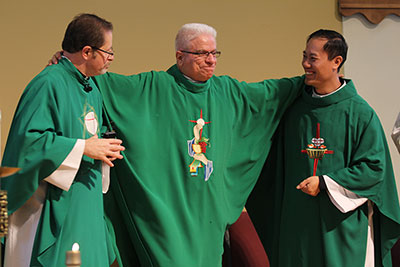 St. Mary’s has been staffed by Vincentian priests since 1939. At the end of Mass Sept. 23 outgoing pastor, Father Charles Strollo, was wished well on his next ministry by incoming pastor Father Bill Allegretto and parochial vicar Father Joseph Nguyen. “Everybody calls me Sister,” she says, proud of her family’s Catholic faith.
St. Mary’s has been staffed by Vincentian priests since 1939. At the end of Mass Sept. 23 outgoing pastor, Father Charles Strollo, was wished well on his next ministry by incoming pastor Father Bill Allegretto and parochial vicar Father Joseph Nguyen. “Everybody calls me Sister,” she says, proud of her family’s Catholic faith.
Two of her aunts became Oblate Sisters of Providence in Baltimore, the only women religious vocations to come out of the parish so far. Her three children also grew up in the parish and attended the parish school.
Smith noted that St. Mary’s diversity is not a recent phenomenon. Decades before immigrants from Mexico and Central and South America moved to the Greensboro area, the parish experienced influxes of immigrants from Nigeria and other African countries, as well as Vietnamese, Montagnard and Hmong newcomers. But the first wave of change came with integration.
“Back in the day, it was not a multicultural church. It was our colored mission,” Smith recalled. Then “a whole slew of white people came,” transferring from New York with Western Electric after World War II and integrating after new parish boundaries were set in the 1970s. “The Galushes, the Henriaks, the Wilcoxes, I remember them all.”
As the parish became more diverse, Smith noted, “a lot of people left.”
But not her. “I’ve got no problem with multiculturalism. We are all one. God made us all. That’s just the way I feel.”
“It’s all I ever know,” she added, then laughed. “I’m Catholic born, I’m Catholic bred, and when I die I’ll be Catholic dead.”
The growth and the mixing of long-time black parishioners and immigrant newcomers – many of whom struggle with learning English and navigating American culture – has not always been easy, parishioners acknowledged.
The Vincentian priests have encouraged the various ethnic and racial groups to mingle, get to know one another, and serve God and one another together – even as the church has added Masses in other languages.
Growth has continued unabated at St. Mary’s. A large parish hall was built on the site of the old school in 2003 to accommodate the increasing number of worshippers and ministries.
Outreach remains integral to the parish’s identity. “We are dedicated to serving the poor, the forgotten and the unloved…,” the parish’s mission statement declares.
Most recently, in April and May, the parish partnered with Catholic Charities staff and volunteers to offer help to victims of a tornado that devastated part of Greensboro and killed one person.
Today St. Mary’s boasts more than 2,000 members from nearly every continent on Earth, and the anniversary celebration Sept. 23 reflected that diversity, with the Mass being offered in English, Spanish and Vietnamese. The Vincentian priests took turns delivering the homily in all three languages as well.
The celebration after Mass featured Mexican Norteño music and Tejano folk dancing, a traditional Vietnamese hat dance, an Igbo dance group performing the traditional “Nkwa Umuagbogho” (“Dance of the Maiden”), and the parish’s League of Lions Vietnamese lion dance team. The Knights of Columbus cooked up 300 pounds of pulled pork and more than 500 pounds of roast chicken.
LEGACY OF SOLIDARITY
In his homily Vincentian Father Bill Allegretto, pastor, reminded the congregation of the parish’s segregated history, when black Catholics in Greensboro “built a refuge – not a fort, but a refuge – a safe harbor, a dwelling place where God’s love can be found again and again and again.”
“They did it in the face of oppression. They did it in the face of resistance. They did this in the face of violence,” Father Allegretto said.
“They wanted to give back to the Lord for all that He did, and they did it with grateful hearts,” he said. “They did it with hearts of how to love in the face of destruction, and dismissal, and diminishment.”
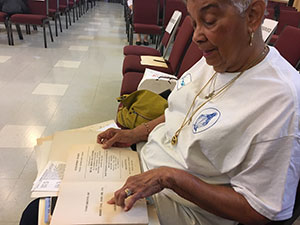 St. Mary’s longest-serving parishioner Virginia Smith looks through historical documents of the parish that she has collected over the years, from parish directories and photos to the pro-grams for the 25th, 50th and 75th anniversary celebrations. He continued, “We are here because of those efforts, because what they did was to create a legacy for all of us to sit here together. How many churches can sit here together with so many different faces of our God’s reflection? Even though we communicate differently, even though we speak from a different culture, from a different pathway, we come because we believe that we have one Lord, one faith, and one baptism.”
St. Mary’s longest-serving parishioner Virginia Smith looks through historical documents of the parish that she has collected over the years, from parish directories and photos to the pro-grams for the 25th, 50th and 75th anniversary celebrations. He continued, “We are here because of those efforts, because what they did was to create a legacy for all of us to sit here together. How many churches can sit here together with so many different faces of our God’s reflection? Even though we communicate differently, even though we speak from a different culture, from a different pathway, we come because we believe that we have one Lord, one faith, and one baptism.”
“We know who we are, we know where we have come from, and we know where we’re going, don’t we? We know we are God’s people, and we’re going to continue to be God’s people because of what happened 90 years ago and what has been built every generation since then,” he said. “Our ancestors – and I will say, our ancestors – gave us a legacy, gave us the hope to gather as a Catholic people from many cultures, many traditions.”
That unity in diversity – symbolized by the parish’s rainbow – is something St. Mary’s members take great comfort in, several people said.
Parishioners proudly sang the gospel hymn “We Shall Overcome,” a key anthem of the civil rights movement, at the recessional before congregating in the narthex and outdoors on the lawn to socialize, give thanks and celebrate their unique yet shared heritage.
“100 percent blessed,” was what Mio Nahria said of St. Mary’s, where she has been a member since 1998. “It’s a great community, great people.”
Theo Kougbany, who moved to Greensboro from Togo 15 years ago, said he loves his parish. “This is my church. It’s good. I love everything!”
GIVING THANKS
The spirit of gratitude extended to the parish’s Vincentian priests, whose bond with parishioners is strong.
At the end of Mass, parishioners David Cao, Bruit K’Bruit, Joseph Kakhu and Sister Delores Espitia – representing the various cultures of the parish – wished outgoing pastor, Vincentian Father Charles Strollo, well on his future ministry with the Vincentian order and welcomed Father Allegretto as incoming pastor.
“Thank you, Father, for your service, your love, your care,” said Cao. “Father Charlie, we cannot tell you how wonderful you are, but you are amazing.”
“You are a great leader and a dedicated pastor, always showing your love for all parish members, guiding St. Mary’s rainbow of cultures into one loving community,” said K’Bruit, representing the Montagnard community.
Parish council president Michael Diamond and Virginia Smith presented gifts to Father Strollo, who is moving to Philadelphia. To Father Allegretto, they gave a framed portrait of himself to hang on the wall – the latest in a long line of pastor portraits displayed there that reflect the parish’s 90-year legacy in Greensboro.
— Patricia L. Guilfoyle, editor. Photos by Patricia Guilfoyle
Wording For St. Mary’s Plaque
-
Wording For St. Mary’s Plaque
 St. Mary’s Parish is steeped in cultural history. It was Father Charles Hannigan’s vision and mission to convert Blacks to Catholicism during an era when segregation of the races was law in the Southern United States. Father Hannigan also wanted these Catholics to have a place to worship. Property for a parish was purchased from the Benbow Estates in southeast Greensboro; an area of the city where Blacks citizens resided. A combination church and school and a house was constructed on the property. The house was intended for the Sisters of Charity who would educate Black students at the school. Once the buildings were blessed; on September 16, 1928 Father Hannigan of the Society of St. Joseph formally opened the new parish. The following day The Sisters of Charity had twelve students in the new school. School enrollment numbers grew rapidly in the months and years that followed. Father Hannigan continued to baptize and bring Black converts into the parish until his departure on August 12, 1930. Before leaving he named the new parish St Mary’s.
St. Mary’s Parish is steeped in cultural history. It was Father Charles Hannigan’s vision and mission to convert Blacks to Catholicism during an era when segregation of the races was law in the Southern United States. Father Hannigan also wanted these Catholics to have a place to worship. Property for a parish was purchased from the Benbow Estates in southeast Greensboro; an area of the city where Blacks citizens resided. A combination church and school and a house was constructed on the property. The house was intended for the Sisters of Charity who would educate Black students at the school. Once the buildings were blessed; on September 16, 1928 Father Hannigan of the Society of St. Joseph formally opened the new parish. The following day The Sisters of Charity had twelve students in the new school. School enrollment numbers grew rapidly in the months and years that followed. Father Hannigan continued to baptize and bring Black converts into the parish until his departure on August 12, 1930. Before leaving he named the new parish St Mary’s.It was under the leadership of the second pastor Father Patrick Darrah, C.P. that the congregation out grew the original facility and the need for a stand-alone church building was realized. The present church building was erected and dedicated on November 1, 1936. In 1939 Father Gerard A. Murphy, C.M. became the first Vincentian priest to pastor St. Mary’s parish. A name change for the parish came in 1949 when a later pastor Father Edward Sellman, C.M. made a request to His Excellency Bishop Waters of the Diocese of Raleigh that the parish be dedicated to Our Lady of the Miraculous Medal. The request was granted and the name officially changed to Our Lady of the Miraculous Medal Parish in January of 1949.
The Supreme Court Decision of 1954 and the Civil Rights Act of 1964 officially abolished public segregation in all of the United States. The process of integration created changes and new opportunities for the parish including the parish name reverting back to St. Mary’s. Integration dramatically affected parish school enrollment to the point that the school closed in June 1972. Additional changes that year included the organization of St. Mary’s first Parish Council and the emergence of a new Diocese in Charlotte. In 1973 the Diocese of Charlotte developed new parish boundaries for the city of Greensboro. These boundaries transformed St. Mary’s from its identity as a Black parish into a new territorial parish. It paved the way for a new chapter of growth at St. Mary’s; as it expanded and grew into a diverse, multicultural congregation. With new parish boundaries in place; white Catholics who had been members of parishes across town came to St. Mary’s. For the first time in its history white and Black Catholic families worshiped and received the sacraments together at St. Mary’s Church as members of a united parish.The next cultural blending for St. Mary’s parish occurred in the early 1980’s as hundreds of African families came to Greensboro seeking educational, employment and other opportunities. They represented many African cultures and traditions. Their homelands included Ghana, Nigeria, and Kenya. As they settled in Greensboro, many attended and later became members of St. Mary’s because of its congenial and family like atmosphere. As members they immediately involved themselves in all aspects of parish committees and commissions. Their traditions have enriched St. Mary’s multicultural heritage.
 On June 19, 1988 Deacon Vincent Shaw became St. Mary’s first Permanent Deacon. In addition a new social ministry evolved in the late 1980’s contributing even more diversity to St. Mary’s ever growing parish population. In cooperation with Lutheran Social Services; the parish began to sponsor Montagard refugee families from Vietnam. The first five families arrived in November 1986. As the sponsorship continued; Pierre K’ Briuh assisted St, Mary’s social ministry with acculturation and as a translator. He was ordained as St. Mary’s second Deacon in June 2001. Additional Vietnamese immigrants also found their way to the United States after the end of the Vietnam War. Most Vietnamese Catholics that settled in Greensboro came to worship at St. Mary’s not only because felt welcomed. They also preferred its small, closed atmosphere. Masses in Vietnamese were celebrated at St. Mary’s by visiting priests, until Father Michael Nguyen, a Vietnamese native, a Vietnamese priest and future pastor of St. Mary’s came in 1995. Weekly Masses in Vietnamese have been celebrated at St. Mary’s since that time. St. Mary’s Vietnamese parishioners have integrated many of their traditions and cultural activities into parish celebrations.
On June 19, 1988 Deacon Vincent Shaw became St. Mary’s first Permanent Deacon. In addition a new social ministry evolved in the late 1980’s contributing even more diversity to St. Mary’s ever growing parish population. In cooperation with Lutheran Social Services; the parish began to sponsor Montagard refugee families from Vietnam. The first five families arrived in November 1986. As the sponsorship continued; Pierre K’ Briuh assisted St, Mary’s social ministry with acculturation and as a translator. He was ordained as St. Mary’s second Deacon in June 2001. Additional Vietnamese immigrants also found their way to the United States after the end of the Vietnam War. Most Vietnamese Catholics that settled in Greensboro came to worship at St. Mary’s not only because felt welcomed. They also preferred its small, closed atmosphere. Masses in Vietnamese were celebrated at St. Mary’s by visiting priests, until Father Michael Nguyen, a Vietnamese native, a Vietnamese priest and future pastor of St. Mary’s came in 1995. Weekly Masses in Vietnamese have been celebrated at St. Mary’s since that time. St. Mary’s Vietnamese parishioners have integrated many of their traditions and cultural activities into parish celebrations.Another diversity leap for St. Mary’s multicultural population also began in the late 1980’s and early 1990’s as thousands of Hispanics individuals and families migrated to North Carolina from other areas of the United States as well as from Mexico and other Spanish speaking countries. The influx of Hispanic Catholics into North Carolina parishes addressed a new need for North Carolina dioceses.
Many new residents were non English speaking. Some were not U.S. citizens. In 1995 Father Vincent Finnerty, CM was appointed Directory of the Hispanic Ministry for the Diocese of Charlotte. For a time he resided at St. Mary’s parish. His arrival at St. Mary’s marked the beginning of celebrating Spanish Masses in the parish for the hundreds of new Hispanics members. A special ministry was also established in Greensboro to offer activities and retreats for the large Hispanics population in Greensboro’s Catholic parishes. The Feast Day of Our Lady of Guadalupe became an important celebration at St. Mary’s for her Mexican parishioners.
Over a half century of ethnic, diverse, population growth propelled St.Mary’s into an era of consolidation, unification and strengthening spiritual bonds within the parish. With the need for additional masses, activities, services and space; in 2003 a new Parish Center was constructed where the school once stood. Descendants of the original parishioners are still vibrant members of St. Mary’s ethnic melting pot. This melting pot of membership is unique, varied, strong and dedicated to a mission of service to others and love for one another.



































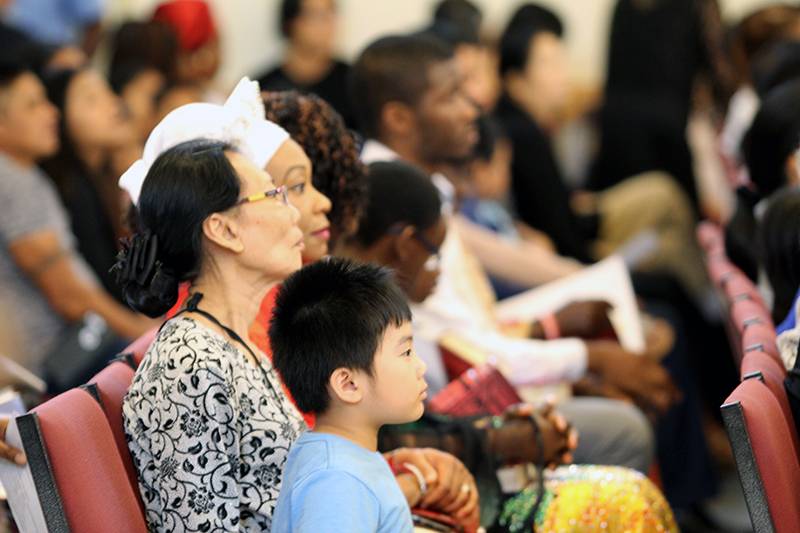






















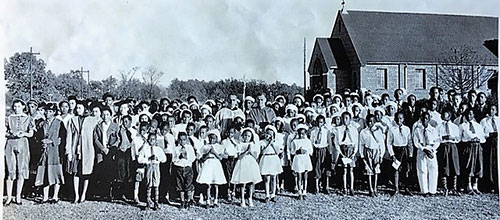 St. Mary’s Parish is steeped in cultural history. It was Father Charles Hannigan’s vision and mission to convert Blacks to Catholicism during an era when segregation of the races was law in the Southern United States. Father Hannigan also wanted these Catholics to have a place to worship. Property for a parish was purchased from the Benbow Estates in southeast Greensboro; an area of the city where Blacks citizens resided. A combination church and school and a house was constructed on the property. The house was intended for the Sisters of Charity who would educate Black students at the school. Once the buildings were blessed; on September 16, 1928 Father Hannigan of the Society of St. Joseph formally opened the new parish. The following day The Sisters of Charity had twelve students in the new school. School enrollment numbers grew rapidly in the months and years that followed. Father Hannigan continued to baptize and bring Black converts into the parish until his departure on August 12, 1930. Before leaving he named the new parish St Mary’s.
St. Mary’s Parish is steeped in cultural history. It was Father Charles Hannigan’s vision and mission to convert Blacks to Catholicism during an era when segregation of the races was law in the Southern United States. Father Hannigan also wanted these Catholics to have a place to worship. Property for a parish was purchased from the Benbow Estates in southeast Greensboro; an area of the city where Blacks citizens resided. A combination church and school and a house was constructed on the property. The house was intended for the Sisters of Charity who would educate Black students at the school. Once the buildings were blessed; on September 16, 1928 Father Hannigan of the Society of St. Joseph formally opened the new parish. The following day The Sisters of Charity had twelve students in the new school. School enrollment numbers grew rapidly in the months and years that followed. Father Hannigan continued to baptize and bring Black converts into the parish until his departure on August 12, 1930. Before leaving he named the new parish St Mary’s.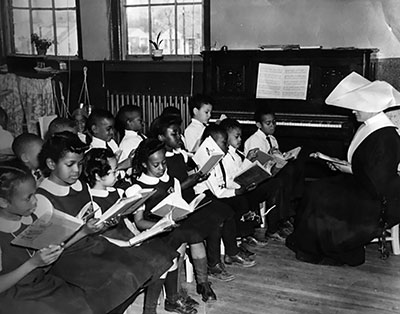 On June 19, 1988 Deacon Vincent Shaw became St. Mary’s first Permanent Deacon. In addition a new social ministry evolved in the late 1980’s contributing even more diversity to St. Mary’s ever growing parish population. In cooperation with Lutheran Social Services; the parish began to sponsor Montagard refugee families from Vietnam. The first five families arrived in November 1986. As the sponsorship continued; Pierre K’ Briuh assisted St, Mary’s social ministry with acculturation and as a translator. He was ordained as St. Mary’s second Deacon in June 2001. Additional Vietnamese immigrants also found their way to the United States after the end of the Vietnam War. Most Vietnamese Catholics that settled in Greensboro came to worship at St. Mary’s not only because felt welcomed. They also preferred its small, closed atmosphere. Masses in Vietnamese were celebrated at St. Mary’s by visiting priests, until Father Michael Nguyen, a Vietnamese native, a Vietnamese priest and future pastor of St. Mary’s came in 1995. Weekly Masses in Vietnamese have been celebrated at St. Mary’s since that time. St. Mary’s Vietnamese parishioners have integrated many of their traditions and cultural activities into parish celebrations.
On June 19, 1988 Deacon Vincent Shaw became St. Mary’s first Permanent Deacon. In addition a new social ministry evolved in the late 1980’s contributing even more diversity to St. Mary’s ever growing parish population. In cooperation with Lutheran Social Services; the parish began to sponsor Montagard refugee families from Vietnam. The first five families arrived in November 1986. As the sponsorship continued; Pierre K’ Briuh assisted St, Mary’s social ministry with acculturation and as a translator. He was ordained as St. Mary’s second Deacon in June 2001. Additional Vietnamese immigrants also found their way to the United States after the end of the Vietnam War. Most Vietnamese Catholics that settled in Greensboro came to worship at St. Mary’s not only because felt welcomed. They also preferred its small, closed atmosphere. Masses in Vietnamese were celebrated at St. Mary’s by visiting priests, until Father Michael Nguyen, a Vietnamese native, a Vietnamese priest and future pastor of St. Mary’s came in 1995. Weekly Masses in Vietnamese have been celebrated at St. Mary’s since that time. St. Mary’s Vietnamese parishioners have integrated many of their traditions and cultural activities into parish celebrations.